Standards and the state of the art

The Medical Device Coordination Group (MDCG) has issued a guidance document on standardization for medical devices. [27] The MDCG is composed of representatives of member states and chaired by the EU Commission. As with all the MDCG guidance, it cannot be regarded as reflecting the official position of the European Commission, or as being legally binding.
The guidance covers a range of topics on standardization and the harmonization of standards to provide a presumption of conformity with European regulatory requirements. One interesting area of the document relates to the frequently discussed relationship between standards and the state of the art.
The guidance stresses that ‘taking into account’ is different from a requirement to ‘comply with’. The guidance goes on to indicate that the state of the art is not legally defined and is difficult to express in a single, clear definition. This is because the term involves several complex aspects. The guidance indicates that it is useful to consider different sources where the term is defined or explained, even if the definition is not legally binding. Two such definitions of ‘state of the art’, with a lot of similarity, are:
- developed stage of current technical capability and/or accepted clinical practice in regards to products, processes and patient management, based on the relevant consolidated findings of science, technology and experience – IMDRF [28]
- developed stage of technical capability at a given time in regards to products, processes and services, based on the relevant consolidated findings of science, technology and experience – BS EN ISO 14971:2019+A11:2021.[29]
The MDCG has also indicated that the most recent published editions of standards should be considered as reflecting state of the art, regardless of whether they are referenced in the Official Journal. The guidance extends this discussion to indicate compliance with the most recent version of a standard does not automatically imply compliance with the requirements of the applicable EU legislation. Furthermore, the use of standards is voluntary. Therefore, the use of a specific standard in the conformity assessment of a product cannot be imposed, not even based on ‘compliance with the state of the art’. The manufacturer needs to have evidence of how the device meets the regulatory requirements in the technical documentation of the product. The guidance clearly states that while a notified body has to check whether device complies with the requirements of the Directives or Regulations on medical devices, it cannot make conformance with any particular standard mandatory. Manufacturers can find it useful to discuss with their notified body how they will review technical documentation regarding the state of the art and references to standards.
The manufacturer has the choice whether to use a standard within its responsibility for compliance of products intended to be placed on the market. The manufacturer also needs to be able to demonstrate how they have ‘taken into account’ the state of the art. This suggests that manufacturers should be aware of, and consider, the latest version of a relevant standard, even if it is not yet cited in the Official Journal.
[27] MDCG 2021-5, Guidance on standarisation for medical devices.
[29] BS EN ISO 14971:2019+A11:2021, Medical devices — Application of risk management to medical devices.
This blog post is an excerpt from our latest whitepaper: Using Standards to Demonstrate Conformity. Please download the full whitepaper to find out more information.
The Compliance Navigator blog is issued for information only. It does not constitute an official or agreed position of BSI Standards Ltd or of the BSI Notified Body. The views expressed are entirely those of the authors.

